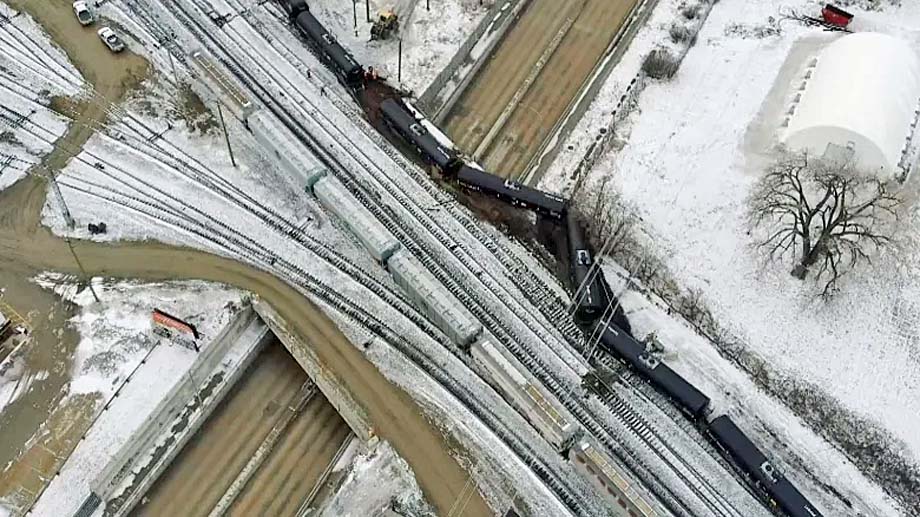
Winterpeg Manitoba - There's nothing quite like a train derailment in the middle of a
Friday-morning rush hour to remind Winnipeg motorists there are worse potential traffic hazards in this city than
springtime potholes.
Just before 08:00 on Friday morning, 12 Canadian Pacific Railway cars carrying undiluted bitumen, a heavy, sludgy,
petroleum product from Alberta's oil sands, slipped off the tracks on a CPKC overpass above McPhillips Street between
Logan and Jarvis avenues.
Nobody was hurt in the incident, which saw the ends of two cars hang over McPhillips Street like sailors trying to
relieve themselves at sea.
Nothing, however, spilled in this derailment.
That's fortuitous considering bitumen is tarry, sticky, and very difficult to clean up.
According to the rail industry, the transport of undiluted bitumen by train poses far more of an environmental hazard
than it does a safety hazard.
For a petroleum product, this stuff is difficult to ignite.
According to Railway Age, a transportation industry publication, undiluted bitumen has a flash point of
151 C.
That's only slightly cooler than the surface of Mercury, the planet closest to the Sun.
To place that in a more earthbound context, a spark can ignite gasoline at -43 C and 80-proof whisky has a flash point
of 26 C.
In other words, McPhillips Street Station didn't come remotely close to erupting into a fireball on Friday
morning.
Still, a narrowly averted environmental accident remains politically unpalatable, even to people in Winnipeg, where a
significant proportion of the population grew up in such close proximity to rail lines, the rumbling of rail cars is
more lullaby than noise pollution.
It is no easy task to separate Winnipeg from its rail lines, which are threaded throughout the city like the tendrils
of a massive mycelium.
Every few years, usually before an election cycle, one politician or another proposes extracting this tangle from
Winnipeg entirely.
This is what third-place mayoral candidate Robert-Falcon Ouellette pledged to do in Winnipeg's 2014 mayoral
race.
It's what former NDP premier Greg Selinger promised to do in January 2016, three months before an election he lost to
the Progressive Conservatives.
The new premier, Brian Pallister, proceeded to cancel Selinger's rail-relocation study within months.
It's also what Winnipeg Mayor Scott Gillingham promised to do in a very modest manner in 2022, when he pledged to study
the repurposing of abandoned spur lines.
"The relocation issue rises and falls periodically on both the general discussion agenda in Winnipeg, and
occasionally makes it onto the institutional agendas of governments, but never moves beyond the study phase," said
Paul Thomas, professor emeritus of political studies at the University of Manitoba.
"It might be described as a zombie idea which we think is permanently dead but always comes back to
life."
This is not to suggest the idea is worthless.
Removing rail lines from the city would not just reduce the potential for environmental accidents in Winnipeg and
emancipate motorists from the indignity of sitting idle in their cars.
Rail relocation would also free up lands for redevelopment and eliminate physical barriers between neighbourhoods, such
as the sprawling CPKC Winnipeg Yards that divide the North End from the inner city.
But there are many barriers to rail relocation.
Dismantling existing rail lines, rail yards, and outbuildings and rebuilding them elsewhere could cost billions of
dollars, especially when you consider the need to build new rail overpasses outside the city.
Such an effort would also require the co-operation of the municipal, provincial, and federal governments as well as the
major railway companies.
The latter are not eager to entertain the idea, as CPKC makes clear in a statement on its website.
"If a community would like to conduct a study into moving certain rail lines out of their city, CPKC may
participate," the company states, wearing its ambivalence on its sleeve.
Given the cost and political capital, it would take a big shift in priorities for Winnipeg to get as far as Regina has
with rail relocation, the study phase, despite a broad political agreement among all three levels of government one
province to the west.
"It would take a fortuitous combination of circumstances to move the idea forward and to translate it into
action," Thomas said.
Nonetheless, there is more agreement now in Winnipeg than there used to be.
The federal government has made some money available to study rail relocation.
Manitoba Premier Heather Stefanson also signalled some receptiveness to the idea on Friday, when she made a clear break
with Pallister on this issue.
"I'm willing to have those discussions to see what that might look like moving forward, and you know, what does
Manitoba look like 10, 20, 30, or 50 years from now as a transportation hub of North America," she said at the
Manitoba legislature.
Would rail relocation actually take half a century for Winnipeg?
"Realistically, even moving quickly it would take a long time," Gillingham said outside his office at City
Hall.
"It's complex and it would be very, very, costly and the major rail lines like CN and CP are significant employers
in this city as well."
That latter comment can be seen as a coded warning.
The mayor seems to be suggesting rail relocation could result in a permanent loss of jobs if the railway companies are
not kept happy.
In other words, even if Winnipeg succeeds in moving rail yards and rail lines outside the city, there's nothing
compelling CPKC or CN to set up new facilities in Rosser, Headingley, or any other Winnipeg bedroom
community.
Flushed out of Winnipeg, CPKC or CN may very well choose to consolidate their operations on the outskirts of Calgary or
Regina.
That situation would rival bitumen for stickiness, even if it seems far off.
Bartley Kives.
(likely no image with original article)
(usually because it's been seen before)
provisions in Section 29 of the
Canadian Copyright Modernization Act.


